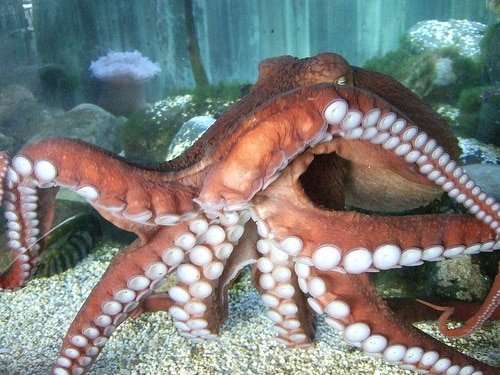
When it comes to breeding, these octopuses are not just about romance; they’re all about strategy. They live in the chilly waters of the Pacific Ocean and can grow up to 16 feet long! But, despite their impressive size, their reproductive habits are quite delicate and fascinating. So, if you’re curious about how these amazing animals mate, lay eggs, and care for their young, you’re in the right place. Let’s dive deeper into the life cycle of the giant Pacific octopus and explore their remarkable breeding and reproductive behaviors.
Understanding the Life Cycle of the Giant Pacific Octopus
The life cycle of the giant Pacific octopus is divided into several phases, each with its own set of challenges and changes. The journey begins when the mother octopus lays her eggs. Generally, a female can lay around 20,000 to 400,000 eggs in one go! Isn’t that wild? She can choose a safe spot in her den or a rocky crevice to lay them, which is crucial for protecting her offspring.
After laying the eggs, the mother octopus typically guards them until they hatch. This period can last anywhere from 4 to 6 months, depending on the water temperature and environment. The mother is fiercely dedicated during this time; she won’t eat or leave the nest. To keep the eggs clean and oxygenated, she uses her arms to gently blow water over them. It’s almost like a full-time job—talk about commitment!
Once the eggs hatch, the tiny octopuses are on their own. They float away as plankton in the ocean, entering the next stage of their life cycle. This phase is full of uncertainty and danger, but it’s also exciting, as they begin to grow rapidly and adapt to their new environment.
How Giant Pacific Octopuses Mate
Mating among giant Pacific octopuses is a fascinating process. Males are smaller than females and have a special arm called a hectocotylus. This unique arm is used to transfer sperm packets to the female during mating. Here’s how it typically unfolds: a male will approach a female, often performing a graceful display of colors and movements to woo her.
If the female is receptive, the male will use his hectocotylus to deliver the sperm packets directly into her mantle cavity. This process can look like a dance, as they intertwine their arms and change colors, creating a mesmerizing spectacle in the water.
Once the mating is complete, the male usually leaves, and the female’s body starts to prepare for egg-laying. Interestingly, females can store the sperm for several months before fertilizing the eggs. This gives them the flexibility to choose the best time for their young to hatch, based on environmental conditions.
Nurturing the Eggs
After the eggs are fertilized, the next stage is nurturing. As we’ve mentioned before, the mother octopus takes her job very seriously. She finds a safe spot to lay her eggs and will spend months protecting them. During this time, she uses her arms to keep them clean and well-oxygenated.
The environment plays a huge role in this nurturing phase. The ideal conditions—like temperature and water quality—can greatly affect the development of the eggs. If the conditions aren’t right, the eggs might not hatch successfully, leading to more challenges for both the mother and her young.
Sometimes, if there’s any danger or disturbance, she may even move the eggs to a new location to ensure their safety. This remarkable ability to adapt is part of what makes the giant Pacific octopus such a resilient species.
After the Eggs Hatch
Once the eggs hatch, baby octopuses emerge as tiny replicas of their parents, though they’re not quite ready to fend for themselves yet. At this stage, they are planktonic and drift with ocean currents, which helps them escape predators. It’s a risky time; many will not survive.
The newly hatched octopuses will spend several months in this planktonic stage, growing and developing before they settle on the ocean floor. During this time, they start changing their diet and learning how to hunt. They begin to mimic the behaviors of adult octopuses, such as hiding from predators and exploring their surroundings.
This stage is crucial for their survival and growth. As they transition from being planktonic to benthic (living on the ocean floor), they start to develop their unique color patterns and textures, setting them up for life as an adult giant Pacific octopus.
Challenges in Reproduction
Even though giant Pacific octopuses have fascinating reproductive strategies, they face several challenges. One major issue is environmental changes. Factors like water pollution, climate change, and habitat destruction can significantly impact their reproductive success.
Another challenge is predation. Many animals, including larger fish and seabirds, see the vulnerable eggs and hatchlings as a tasty snack. The protective measures the mother adopts, like choosing the right nesting site, are crucial to combat these threats.
Understanding these challenges is essential for conservation efforts. By protecting their habitats and ensuring cleaner oceans, we can help the giant Pacific octopus thrive in the wild.
The breeding and reproduction of the giant Pacific octopus is a captivating blend of dedication, strategy, and survival. From the first dance of courtship to the nurturing of eggs and the challenges faced by the hatchlings, every step is essential for the continuation of their species.
These octopuses remind us of the intricate balance of life in the ocean—how each creature plays a role in maintaining the ecosystem. As we continue to learn more about these incredible animals, it becomes increasingly clear how important it is to protect their habitats and ensure their survival for future generations. Who knew that beneath the waves, there’s such a rich tapestry of life and love unfolding?
